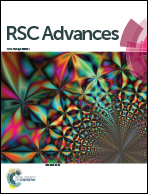Chemiluminescence determination of ascorbic acid using graphene oxide@copper-based metal–organic frameworks as a catalyst
Abstract
In this work, composites with different amounts of graphene oxide (GO) and the copper-based metal–organic frameworks (HKUST-1) were synthesized. They have been applied in chemiluminescence (CL) as catalysts using the luminol–H2O2 system as a CL model for the first time. The results showed that the well-dispersed GO@HKUST-1 (GMs) greatly improved the CL intensity of the luminol–H2O2 system, up to 359-fold. Based on ascorbic acid (AA) inhibiting the CL of the luminol–H2O2–GMs system, a flow injection CL method for monitoring AA was developed. Under the optimized conditions, a good linear relationship was obtained from 0.001 μM to 10 μM, and the detection limit was 0.35 nM. Moreover, the method was successfully used to detect AA in commercial food and fruit juices with satisfactory results. Due to their fascinating features, the GMs would offer a suitable catalytic platform for CL systems and provide potential promise for the construction of CL sensors.


 Please wait while we load your content...
Please wait while we load your content...